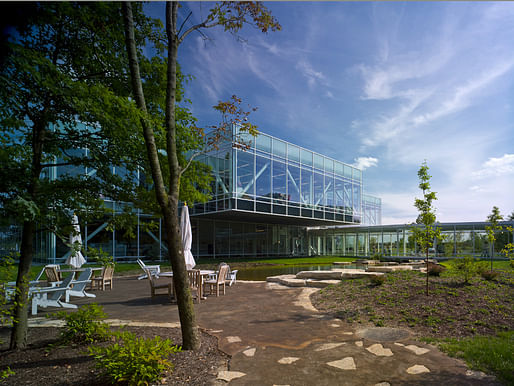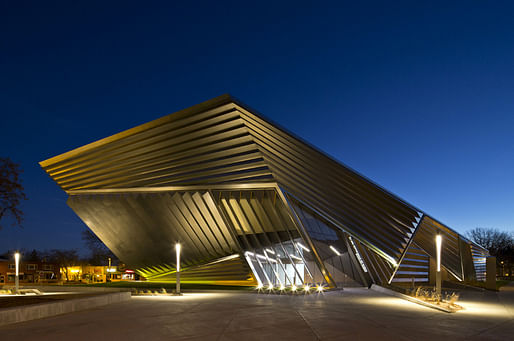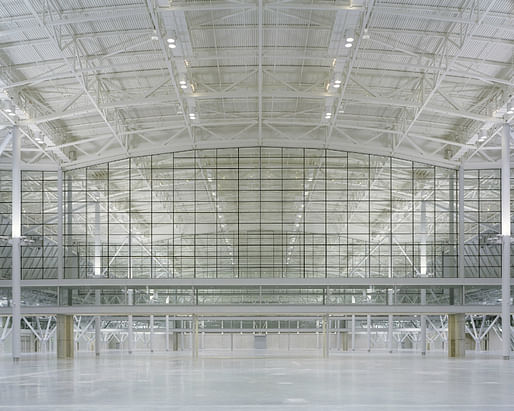
Photography & Architecture makes the work of architectural photographers more transparent, offering information and resources on what the industry and its professionals are like. More than ever, the reputation of an architect rests upon images of their built work, but the professional relationship between architect and photographer isn’t always clear.
To help bridge that gap, Archinect presents Wide Lens, a monthly column from P&A editor, Julie Grahame.
For the inaugural issue, Julie shared with us an interview with architectural photographer Brad Feinknopf.

Julie Grahame:
Our colleague Brittain Stone spoke with Brad Feinknopf, a seasoned architectural photographer based in Columbus, Ohio, so that he could relay the way that he helps architects defray the upfront cost of a multi-day, high-end architectural shoot. But first, a little about Brad. His father and grandfather were both architects, and he’s been photographing architecture professionally for over 25 years. Prior to that he assisted such little known photographers as Arnold Newman, Avedon, Mapplethorpe and Horst. He spends about 40% of his time on the road and is famously a lean shooter: few lights, not much gear, one assistant. He’s repped by Katie Swanson in Chicago.
Since Brad is pretty established, he’s an interesting predicament: he wants to deliver value to his client, but he’s never going to be the cheapest way to go.
Brad Feinknopf: I can say that I’m very fortunate that when my phone rings, a good percentage of the time, it’s from someone who wants me to photograph a building for them, and quite frankly if someone calls me up and they want me to bid on a project, I’m really just not that keen on writing an estimate… Because I know that I’m just not going to be the low bidder.
Photography & Architecture: How do you present that architect with a strategy of lowering the upfront costs, getting everything you want out of it, producing images with a long life, and keep everyone happy at the end?
BF: I can talk to this very clearly, as these are things that I’ve been very effective at doing. I think I have benefitted from the standpoint that my father and grandfather were both architects, so I’ve got a good grasp on what kind of financial constraints architects are under. I always approach things in a very empathetic fashion. Photography is an expensive undertaking and we need to... We need to figure out a way in which we can make this work.
I start on a lot of projects trying to work with the architect to look at who else is involved that might be able to share in the cost of the photography. In virtually every case, especially if it’s a larger project, there’s a design architect, an architect of record. Then there’s often a construction manager and a general contractor. There’s an engineer; there’s a client, so right there, there’s quickly six people who could be sharing in the cost of that project.

P&A: When you’re referring to a client, are they generally a developer?
BF: No, in fact, almost always an architect. Architects are much more invested in what they’re doing [with the photography]. It’s what they’re going to use for the next ten years to build their reputations. It’s what they’ll hopefully win awards with.
I want to preface this by saying that if I’m shooting for 2, 3, 4, 5, 6 people, the fee is not the same fee as if I were shooting for one. If two people are sharing the photography, then the imagery is getting double the use, or triple for three, etc. I bill more for each and every client.
A perfect example is a project that we did this past summer, and Katie [Swanson] was part of it. The architect gave us the name of 11 different parties that were involved in the building in some respect or another. Some of them were more AEC (architecture, engineering, construction) industry people, and some of them were more in Katie’s world (material suppliers, marketers, realtors). We sent out an email to all 11 of them and said if you participate in the shoot - we can’t tell you exactly what the breakdown would be - but we said if all 11 of you get on board, the price will be x, and for 10 of you, the price will be y, and on down.

We also clarify for those people who are material providers and will be using it for advertising and whatnot, this is [only] the price for the “buy in” to the photography. If they want to use images for some print advertising, Katie will have to negotiate that with them, and [the buy in] would be at a reduced price.
P&A: So the “buy in” would be reduced, and then they could negotiate usage for print and advertising?
BF: Exactly. To participate in the shoot was still going to be more cost effective than to hire somebody independently to shoot the building for advertising purposes.
When all was said and done, 9 out of 11 got on board. It was very reasonable. We did about 30 shots and a time lapse video. So people walked away with a great amount of photography for a very incidental cost.
P&A: Now did that include all your expenses?
BF: It included my time, assistant’s time, the retouching of the files, all that kind of stuff. So, It was very cost effective for everybody. And it was also a nice job for me.
I do cost sharing on almost every single project I work on, but I would say very few people see what the total budget is, and I think that’s probably a good thing. If you shared the budget with all the parties involved, most of them would feel that was excessive. I have a pretty good assessment of where people’s financial comfort level is.
On a large project, I have a specific day rate. For each additional participant, I charge another 25% of my creative fee, capped at 50% of the day rate. We’re going to ask people to pay x to be a full participant, and if they get gun shy, I will tell my architect client “Don’t push that party away. If we’re planning on doing 30 shots, for 75% of x, you let them have 17 or 18 shots. Or for 50% of x maybe they get 9 shots.”

P&A: You’re negotiating with each person separately?
BF: Not exactly, I’m typically negotiating with the architect. Somebody has to be the point person and I always find it best for it to be the architect, because I find the architect has the greatest opinion. If you can walk away with the architect pleased, then everybody else will be happy, because the architect is always the hardest one to please.
If you look at my client list, an awful lot of my clients start to work with me and don’t cease to work with me. I’ve got clients that are up to 20 years with me.
I’m one of those odd people - probably because my father and grandfather were architects - who in fact enjoys working with architects.

No Comments
Block this user
Are you sure you want to block this user and hide all related comments throughout the site?
Archinect
This is your first comment on Archinect. Your comment will be visible once approved.